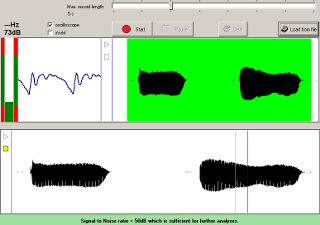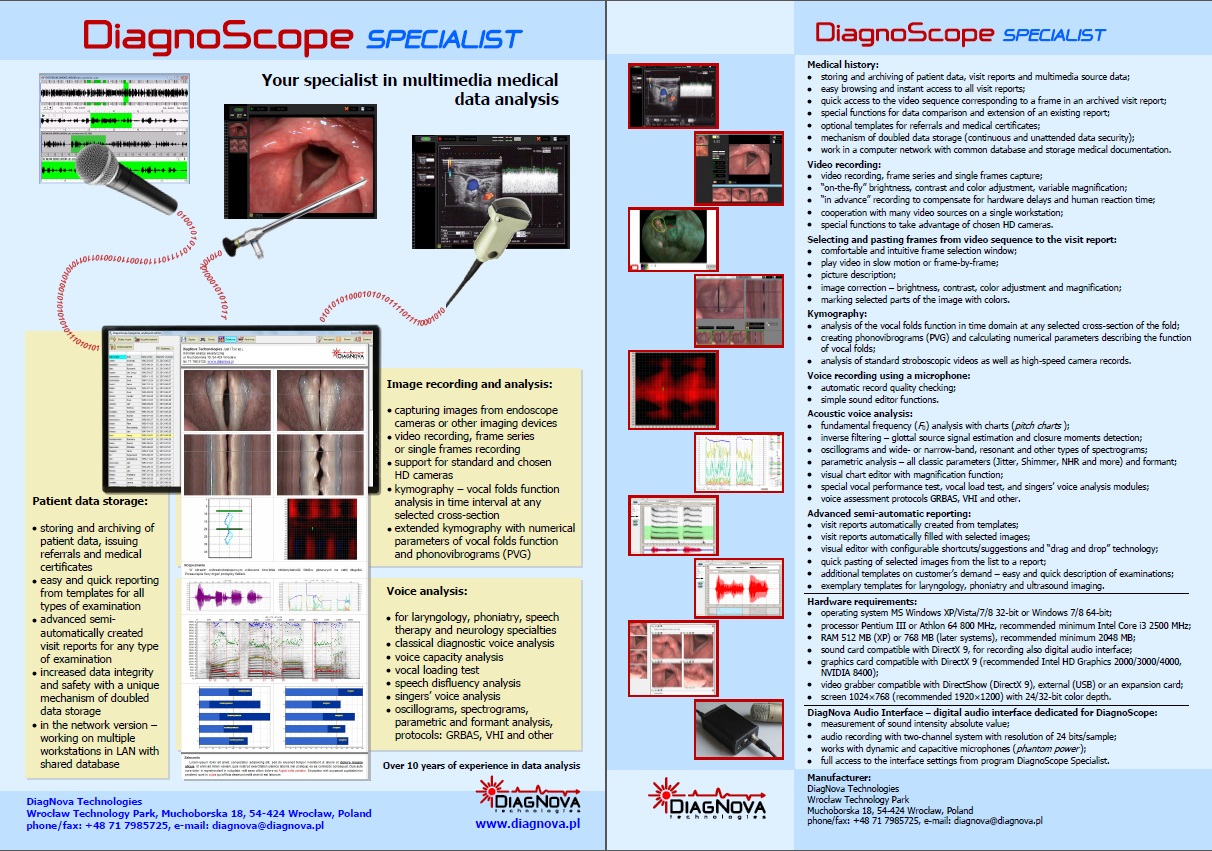DiagnoScope – voice analysis and video recording environment
DiagnoScope (the previous version, for phoniatry only, was called DiagnoVoice) is our original software for full voice analysis with new advanced and enhanced modules. The version DiagnoScope Specialist (previously named DiagnoVoice Basic), designed for individual practitioners, is available since the beginning of 2010. The version DiagnoScope Clinic (previously named DiagnoVoice Lite) is available. This version is designed for polyclinics.
Characteristics of DiagnoScope Specialist:
- “a” vowel analysis,
- phrase analysis,
- long phrase analysis,
- voice capacity analysis,
- vocal loading test,
- singers’ voice analysis,
- speech disfluency analysis (stuttering),
- voice recording,
- voice processing with recording quality control,
- recording in advance,
- recording based on model curve,
- fundamental frequency (F0) analysis,
- parametric analysis, formant analysis,
- long-term analysis,
- inverse filtering,
- scale measurement,
- LTAS long-term spectrum,
- creating oscillograms and spectrograms,
- automatic determining the length of phonation,
- automatic, configurable reporting,
- saving on any data-storage medium informations about report with all data,
- templates for specialist examinations,
- templates for referrals and medical certificates,
- installation and full configuration of program,
- modular construction allows individual configuration,
- optional modules on clients demand,
- attendance of chosen HD cameras,
- working in MS Windows 7, 8, 10, 11 environment,
- additional video recording module.
DiagnoScope Specialist modules:
- “A” vowel analysis – voice sample analysis based on vowel “a” extended phonation with possibility to evaluate voice acoustic parameters using standards, allows full voice folds diagnostics, also for detection of laryngeal cancer,
- Phrase analysis – voice sample analysis based on any phrase or sentence, allows to evaluate words intonation, and also allows sample comparison to examine any changes,
- Long phrase analysis – allows to record long phrase or whole long speech, to analyze a fragment of it later using “a” vowel analysis or phrase analysis,
- Voice organ capacity analysis – voice capacity analysis based on time measurement and long-term parameters of the longest phonation, allows to evaluate voice capacity,
- Vocal loading test – vocal loading test allows for voice quality assessment as a consequence of increasing vocal effort; defines acoustic parameters value changes during reading a long text,
- Singers’ voice analysis – voice field analysis, scale measurement with evaluation of the vocal folds near the limits of the scale and near the register transitions, support voice training, voice emission exercises, and also allows to diagnose voice disorders like dysphonia.
- Speech disfluency analysis – voice sample analysis in segmental form, which is a vowel, phrase or sentence repeated several times; allows for speech fluency quality assessment and can be used in the assessment of stuttering.
Features:
- Voice recording recording using a microphone
- simple sound editor functions,
- record quality checking,
- setting the length of recording,
- recording a very long speech (long phrase analysis),
- recording in advance (voice capacity analysis),
- recording “a a” extended phonation every 60 seconds during increasing vocal loading (vocal loaded test),
- recording a vowel, phrase or sentence repeated 3 to 30 times (speech disfluency analysis);

Voice recording window
- Singers’ voice recording:
- smooth frequency change recorded with time,
- model frequency given on screen in the form of a curve, or as a reference signal,
- fundamental voice frequency relative to frequency of the model curve,
- model frequency matched to singers’ vocal scale;

Singers’ voice sample recording window with model curve
- Fundamental frequency (F0) analysis:
- mean,
- maximum and minimum values,
- stability,
- enhanced statistics,
- pitch chart;

Example output of a fundamental frequency analysis
- Inverse filtering:
- glottal source signal estimation,
- glottal closure moments detection;
- Oscillograms with zoom function;
- Spectrograms: multiple types (wide- and narrow-band, resonant, (F0)-synchronized, enhanced contrast with formants removed);
- Parametric analysis:
- advanced statistics,
- all classical parameters (Jitter, Shimmer, NHR, Yanagihara, Unharmonic-to-Harmonic, and much more),
- long-term parameters analysis (voice organ capacity analysis),
- parameter analysis against fundamental frequency (singers’ voice analysis),
- specific parameters for speech disfluency assessment (speech disfluency analysis);
- Formant analysis;
- Voice profile;
- Scale measurement based on phonation frequency range;
- Long-Term Average Spectrum (LTAS) type of a long-term spectrum:
- information, what portion of the total energy is transmitted in a specific frequency band,
- signal power mean value as a function of frequency,
- spectrum determined in every acoustic analysis,
- determine also LTAS parameters;
- Voice capacity:
- automatic determination of phonation length without manual measurement,
- results automatically putted in the report,
- special long-term parameters;
- Vocal loading:
- voice acoustic parameters assessment during vocal effort,
- recording test phrase (in example “a a” extended phonation) every 60 seconds,
- vocal effort by reading very long text,
- automatically displayed text to read,
- automatically displayed message asking to say phrase;
- Visual chart editor;
- Advanced semi-automatic, configurable reporting: visit report forms are:
- automatically created from templates,
- automatically filled with selected images,
- can be edited in a visual editor;

Automatically created and filled visit report
- Built-in expert system for computer-aided diagnosing;
- Additional documents:
- optional templates created on clients demand for referrals and medical certificates,
- fast access from main window,
- easy template edition if needed;
- Medical history:
- storing of patient data and visit reports,
- instant access,
- easy browsing,
- data comparison functions,
- complement of the existing report.

Main program window with patient data and visit reports
DiagnoScope allows full acoustic diagnosis and diagnosis of laryngeal cancer, singer’s module, laryngeal diseases or occupational diseases to vote. In addition to voice analysis, DiagnoScope is designed for endoscopic video recording and allows complex phoniatric and laryngological examination. The program includes full video imaging support for laryngovideostroboscopy.
Hardware requirements:
- • Minimum requirements (for „a” vowel analysis, voice organ capacity analysis, speech disfluency analysis)
- Processor: Intel Core2 Duo 2,4 GHz, Intel i3 2,0 GHz;
- RAM at least 2048 MB;
- Operating system: MS Windows 7/8/10 64-bit;
- Digital audio interface (USB) or integrated sound card with an external pre-amplifier.
- • Minimum requirements (for singers’ voice analysis and vocal loading analysis)
- Processor: Intel i3 3,6 GHz;
- RAM at least 8192 MB;
- Operating system: MS Windows 7/8/10 64-bit;
- Dedicated digital DiagNova Audio Interface (2-channel version).
In parallel, we are working on a simple and cheap glottograph in order to provide comprehensive solutions for phoniatry.
Additional information:
We invite you to learn more about the program's capabilities and its support. They are described in detail in the user's manual, which can be obtained free of charge in electronic form, by writing to the e-mail address serwis@diagnova.pl.
